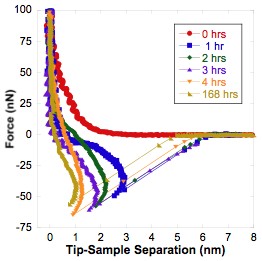562d Wetting Dynamics of Bonded Perfluoropolyether (PFPE) Thin Films Revealed by AFM
Perfluropolyether (PFPE) thin films perform critical lubrication and wear-resistance functions in magnetic data storage systems. To provide strong anchoring, PFPE oligomers with terminal hydroxyl groups are bonded to the underlying media by heat treatment or UV irradiation which gives rise to hydrogen bonding between the PFPE endgroups and polar groups on the media. The disjoining pressure of PFPE films is an important operational parameter used to judge their flow properties in the presence of externally imposed defects, and can be assessed using AFM-derived force-extension curves. Here, the AFM probe is initially contacted to the PFPE film, then retracted at a slow rate, stretching the liquid bridge formed between the probe tip and the film substrate. Various models, including one developed in our previous work, can be used to fit these force-extension curves to obtain the disjoining pressure. This methodology fails in the case of some bonded PFPE films, as the flow dynamics are too slow to establish equilibrium between the liquid bridge and the underlying film during the stretching experiment. In this case, we have instead made the interesting (and to our knowledge, unique) observation that AFM force curves collected on the approach cycle show an apparent film expansion as the tip-surface force is increased. Further, this unusual feature tracks the extent of PFPE bonding and is non-existent in the absence of bonding. The experimental system we present consists of the perfluoropolyether lubricant Fomblin Zdol deposited on a hard drive platter covered with a diamond-like carbon (DLC) overcoat. Zdol hydrogen bonds to this overcoat through its terminal alcohol groups during a heating process. The length of this heating process determines the extent of surface bonding. Unmodified AFM tips are used with a fairly high (ca. 15 N/m) spring constant for the measurements. On the approach cycle, we observe a jump to contact, followed by an apparent film expansion and eventual compression as shown in the attached figure. The size of the expansion feature varies with the extent of heat treatment used to bond the PFPE film to the DLC surface as shown. We believe the feature is likely due to the flow of PFPE material displaced by the initial contact back into the film surrounding the AFM tip, providing a transient repulsive force. This assertion is supported by a number of experiments that reveal the dependence of the phenomenon on tip approach velocity and the apparent requirement of liquid bridge formation between the tip and the DLC surface. Others have shown that when no bonding sites are available on the substrate Zdol hydrogen bonds with itself. We demonstrate that this self-interaction manifests itself as autophobic dewetting at certain film thicknesses. Dynamic ellipsometry demonstrate that lubricant flow is impeded at these critical thicknesses. The implication for our AFM experiments is that the meniscus becomes pinned at certain positions. The inability to drain quickly through these regions as the tip approaches the surface causes the meniscus to bulge and assume a positive (repulsive) curvature. This produces the anomalous expansion before the tip-sample contact relaxes into standard deformation of the lubricant film. We discuss our efforts to model this unusual dynamic wetting phenomenon and its ability to reveal PFPE end group-surface bonding properties vital to the development of next-generation hard-disk lubricants.
